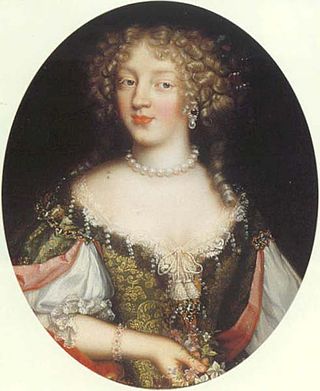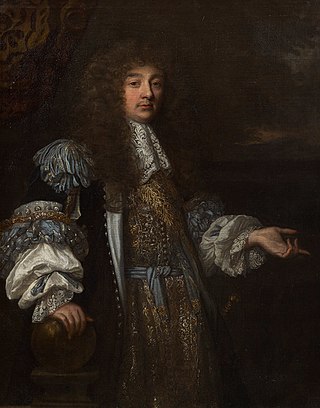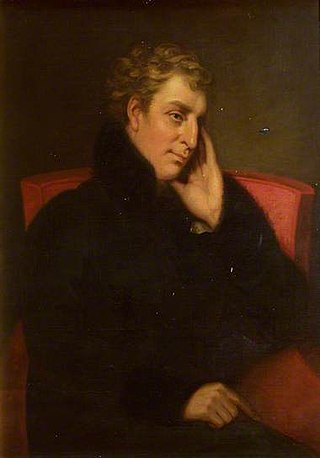
Frances Talbot, Countess of Tyrconnell, also called La Belle Jennings, was a maid of honour to the Duchess of York and, like her sister Sarah, a famous beauty at the Restoration court. She married first George Hamilton and then Richard Talbot, Earl of Tyrconnell. She was vicereine in Dublin Castle while Tyrconnell was viceroy of Ireland for James II. She lived through difficult times after the death of her second husband, who was attainted as a Jacobite, but recovered some of his wealth and died a devout Catholic despite having been raised as a Protestant.

Wentworth Dillon, 4th Earl of Roscommon (1637–1685), was an Anglo-Irish soldier and poet.

Henry Folliott, 1st Baron Folliott (1568–1622) was an English soldier in the Irish army. He fought in the Nine Years' War and then in the suppression of O'Doherty's rebellion at the Siege of Tory Island.

Theobald Dillon, 7th Viscount Dillon of Costello-Gallin supported King James II, was attainted on 11 May 1691, and fell in the Battle of Aughrim during the Williamite War. His attainder was reversed in favour of the 8th Viscount on 20 June 1694.

Henry Dillon, 8th Viscount Dillon was an Irish soldier and politician. In 1689 he sat in the Patriot Parliament. He fought for the Jacobites during the Wiiliamite War, defending Galway against Ginkel and surrendering it in 1691 after a short siege. He obtained the reversal of his father's attainder in 1696 recovering his father's lands.

Charles Henry Dillon-Lee, 14th Viscount Dillon (1810–1865), was an Irish and English landowner. He lived in Ditchley, Oxfordshire, England, and was represented in Ireland by his agent Charles Strickland.

Charles Dillon-Lee, 12th Viscount Dillon, KP, PC (Ire) (1745–1813) conformed to the established religion in 1767 and inherited Ditchley in England from his mother.

Henry Augustus Dillon-Lee, 13th Viscount Dillon (1777–1832), was an Irish politician, soldier and writer. Despite being a Protestant, he supported Catholic emancipation in Ireland and wrote on the topic. He sat as MP for Harwich in England in the last parliament of Great Britain and the first parliament of the United Kingdom. In the second parliament of the United Kingdom he sat for County Mayo in Ireland. Through his daughter Henrietta, He was ancestors to Clementine and to the Mitford sisters.

Thomas Dillon, 4th Viscount DillonPC (Ire) (1615–1673) held his title for 42 years that saw Strafford's administration, the Irish Rebellion of 1641, the Irish Confederate Wars and the Cromwellian Conquest of Ireland. He was a royalist and supported Strafford and Ormond. He sided with the Confederates for a while but was a moderate who opposed Rinuccini, the papal nuncio.

Theobald Dillon, 1st Viscount Dillon, was an Irish military commander and adventurer. He held extensive lands in eastern Connacht and north-western Leinster, some acquired by sharp practices. He was a loyal supporter of Elizabeth I of England in her Irish wars.
Arthur Dillon, Count Dillon (1670–1733) was a Jacobite soldier from Ireland who served as colonel of Dillon's Regiment in the Irish Brigade in French service. He fought in the Nine Years' War and in the War of the Spanish Succession where he excelled at the Battle of Cremona against Prince Eugene of Savoy.
Sir William Talbot, 1st Baronet, was an Irish lawyer and politician. He sat as MP for County Kildare in the Parliament of 1613–1615 and was in 1628 one of the negotiators of the Graces. However, he is probably mainly remembered as the father of Richard Talbot, 1st Earl of Tyrconnell.
Sir Valentine Browne, 1st Viscount Kenmare and 3rd Baronet Browne of Molahiffe (1638–1694), was an Irish Jacobite who fought for James II of England in the Williamite War in Ireland.
Sir William Parsons, 1st Baronet of Bellamont, PC (Ire), was known as a "land-hunter" expropriating land from owners whose titles were deemed defective. He also served as Surveyor General of Ireland and was an undertaker in several plantations. He governed Ireland as joint Lord Justice of Ireland from February 1640 to April 1643 during the Irish rebellion of 1641 and the beginning of the Irish Confederate War.
James Dillon, 1st Earl of Roscommon fought for the crown in the Nine Years' War. He was ennobled despite being a Catholic after his son Robert turned Protestant.
Carey or Cary Dillon, 5th Earl of Roscommon, PC (Ire) (1627–1689) was an Irish nobleman and professional soldier of the seventeenth century. He held several court offices under King Charles II and his successor King James II. After the Glorious Revolution he joined the Williamite opposition to James and was in consequence attainted as a traitor by James II's Irish Parliament in 1689. In that year he fought at the Siege of Carrickfergus shortly before his death in November of that year.
Ulick Burke, 1st Viscount Galway was an Irish army officer slain at the Battle of Aughrim while fighting for the Jacobites during the Williamite War in Ireland.
William Talbot of Ballynamony in County Wexford, also known as Wicked Will, was an Irish Jacobite. He represented Wexford Borough in the Patriot Parliament. He fought for James II during the Williamite War in Ireland at the Siege of Derry where he was wounded and captured. He died of his wounds while a prisoner in the besieged city.
James Talbot of Templeogue was an Irish Jacobite who served James II in the Irish Army during the War of the Two Kings (1689–91) and was killed at the Battle of Aughrim.
Robert Dillon, 2nd Earl of RoscommonPC (Ire) was styled Baron Dillon of Kilkenny-West from 1622 to 1641 and succeeded his father only a year before his own death. He supported Strafford, Lord Deputy of Ireland, who appointed him keeper of the great seal. Dillon was in December 1640 for a short while a lord justice of Ireland together with Sir William Parsons.